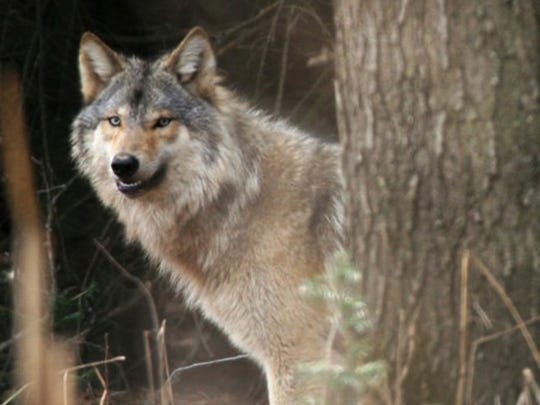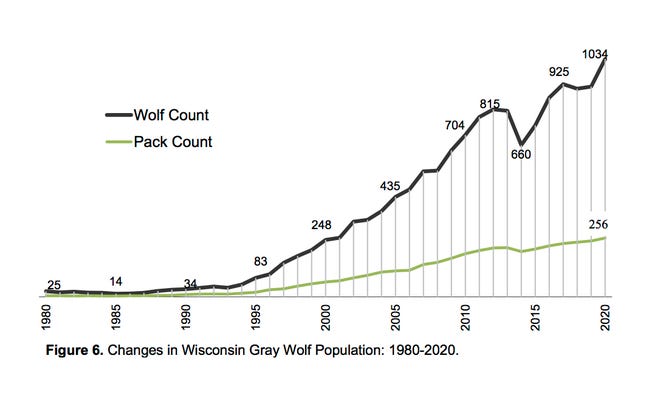Paul A. SmithMilwaukee Journal Sentinel October 29, 2020

The gray wolf has recovered in the lower 48 states and no longer needs protections of the federal Endangered Species Act, the U.S. Fish and Wildlife Service declared Thursday.Therefore, the agency will delist the wolf and return management authority to the states.
“The gray wolf has exceeded all conservation goals for recovery,” said David Bernhardt, Secretary of the Interior. “Today’s announcement simply reflects the determination that this species is neither a threatened nor endangered species based on the specific factors Congress has laid out in the law.” The decision, scheduled to take effect in early January, clears the way for the use of lethal control measures, including controversial wolf hunting and trapping seasons.
It’s the latest move in a decades-long legal and cultural seesaw over best management practices for the native large carnivore that plays a keystone role in ecosystems and is revered in American Indian traditions but also causes conflicts with farmers and kills livestock.
Thursday’s announcement, expected for more than eight months, marks the fourth time wolves have been federally delisted.
Like the other actions, this one is certain to be challenged in court.
Those with agricultural and hunting interests generally supported the move, while environmentalists, tribal representatives and animal protectionists were opposed.
“We welcome this decision and hope it brings closure and celebration to the restoration of the wolf in the lower 48 states,” said Tim Brady, president of the Boone and Crockett Club.
Brady said the goal of the Endangered Species Act is to assist imperiled species so they no longer require the protections offered by the act, and the wolf “is a good example of how a species can be recovered.”
But others, including many in the scientific community, don’t agree wolves have been adequately restored to former habitats.
“This is no ‘mission accomplished’ moment for wolf recovery,” said Kristen Boyles, Earthjustice attorney. “Wolves are only starting to get a toehold in places like Northern California and the Pacific Northwest, and wolves need federal protection to explore habitat in the Southern Rockies and the Northeast.”
What is beyond dispute is the increase in wolf numbers, especially in Wisconsin.
Over more than a century of persecution, including bounties and poisoning, wolves were eradicated everywhere in the lower 48 states but Minnesota. But after new protections were enacted, including the Endangered Species Act in 1973, the species began to rebound.
Individual wolves began to drift into northern Wisconsin from Minnesota in the 1970s, and the population slowly became re-established in the Badger State.
This year the Wisconsin wolf population was estimated at 1,195 animals and 256 packs, according to the state Department of Natural Resources, both modern-era highs for the species in the state.

All told, there are about 6,000 wolves in the lower 48 states, “exceeding the combined recovery goals for the Northern Rocky Mountains and Western Great Lakes populations,” according to the Fish and Wildlife Service.
The delisting will put pressure on the Wisconsin DNR to decide when and how to hold a public wolf harvest as required by state law.
Aaron Buchholz, DNR deputy division administrator, said wildlife staff will meet very soon with the agency’s legal team and the DNR Secretary’s Office to determine the next steps for wolf management in the state, including a hunting season.
Since the delisting rule doesn’t take effect until January, no legal wolf hunting and trapping will take place this year and is unlikely before fall 2021.
The DNR also needs to update its wolf management plan, written in 1999. Further, it needs to bring together conservation groups, tribal representatives, farmers and wolf advocates to help guide management.
In a statement, the DNR indicated it welcomes the responsibility of wolf management.
“The department has successfully managed wolves for decades and will continue to follow the science and laws that influence our management strategies,” the statement read. “All wolf management, including hunting, will be science-based and conducted in a transparent and deliberative process. Public and tribal participation will be encouraged, and we welcome all respective viewpoints.”
In 2012, during the last period of state management, the DNR was criticized for forming an anti-wolf committee that sought to drastically reduce wolf numbers.
In the three seasons (2012-14) of state control, hunters and trappers killed 117, 257 and 154 wolves, respectively. The DNR expressed its objective at the time to “put downward pressure” on the wolf population but did not have a stated population goal.
Years have passed and the wolf population has increased, but the agency has yet to establish a target or new plan for the species.
Surveys in Wisconsin (2014) and Minnesota (2019) showed a majority of state residents supported maintaining a wolf population at current levels.
Through a statement from the Great Lakes Indian Fish and Wildlife Commission, American Indian tribes on Thursday reiterated their opposition to wolf hunting and trapping in Wisconsin.
“GLIFWC member tribes have made it clear to federal and state agencies that they are opposed to delisting ma’iingan (wolves) and have advocated for high levels of protection of our relative,” wrote Michael Isham, Jr., GLIFWC executive administrator. “Furthermore, we remind the Department of Interior that the trust responsibility to the tribes in the realm of ma’iingan stewardship does not cease with delisting, but rather increases the need for their active involvement in protecting tribal interests.”
Eleven Ojibwe bands in Wisconsin, Michigan and Minnesota are represented by GLIFWC to manage and preserve the tribes’ off-reservation treaty rights and resources.
Sarah Wilkins, science director for Wisconsin’s Green Fire, said the wolf population has reached a healthy level and her conservation organization supports the resumption of state and tribal management of wolves in Wisconsin.
However, she said current statutory mandates and the outdated 1999 Wisconsin wolf management plan hinder the effective conservation of the state’s wolf population.
She urged the DNR to immediately resume work on developing a new state wolf conservation plan using the best science and public attitude data available as well as re-establish a diverse advisory committee.
“This will allow for an inclusive and transparent wolf governance process that reflects public perceptions and incorporates the latest social and ecological science on wolves in Wisconsin,” Wilkins said.
At the federal level, it remains to be seen whether this delisting decision will withstand legal challenges.
“Stripping protections for gray wolves is premature and reckless,” said Defenders of Wildlife President and CEO Jamie Rappaport Clark. “Gray wolves occupy only a fraction of their former range and need continued federal protection to fully recover. We will be taking the USFWS to court to defend this iconic species.”
A U.S. Fish and Wildlife Service spokesman said the rule was slated to be published Tuesday in the Federal Register and by rule would become effective 60 days later, Jan. 2.
